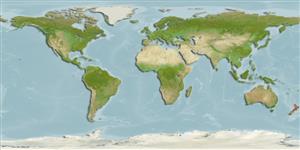Actinopterygii (ray-finned fishes) >
Perciformes (Perch-likes) >
Tripterygiidae (Triplefin blennies) > Tripterygiinae
Etymology: Bellapiscis: Latin, bellum = war + Latin, piscis = fish.
Environment / Climate / Range
Ecology
Marine; demersal; non-migratory; depth range 0 - 5 m (Ref. 9003). Temperate, preferred ?
Southwest Pacific: endemic to New Zealand.
Size / Weight / Age
Maturity: Lm ? range ? - ? cm
Max length : 7.5 cm SL male/unsexed; (Ref. 9003)
Short description
Morphology | Morphometrics
Adults occur in rock pools and surge zones. They may remain out of water under rocks or seaweed (Ref. 31184). They feed on mollusks and minute crustaceans, including barnacles. This agile species eludes predators by alternately remaining motionless, then rapidly darting to a new location. Feeding occurs even in the swash zone where the fish rapidly darts with the surge and clinging to the rock as the water recedes, often being left exposed on the damp open rock (Ref. 26966). Eggs are hemispherical and covered with numerous sticky threads that anchor them in the algae on the nesting sites (Ref. 240). Larvae are planktonic which occur primarily in shallow, nearshore waters (Ref. 94114). They breathe air when out of water (Ref. 31184).
Life cycle and mating behavior
Maturity | Reproduction | Spawning | Eggs | Fecundity | Larvae
Fricke, R., 1994. Tripterygiid fishes of Australia, New Zealand and the southwest Pacific Ocean (Teleostei). Theses Zool. 24:1-585. (Ref. 13227)
IUCN Red List Status (Ref. 115185)
CITES (Ref. 94142)
Not Evaluated
Threat to humans
Harmless
Human uses
Fisheries: of no interest
More information
Age/SizeGrowthLength-weightLength-lengthLength-frequenciesMorphometricsMorphologyLarvaeLarval dynamicsRecruitmentAbundance
ReferencesAquacultureAquaculture profileStrainsGeneticsAllele frequenciesHeritabilityDiseasesProcessingMass conversion
Tools
Special reports
Download XML
Internet sources
